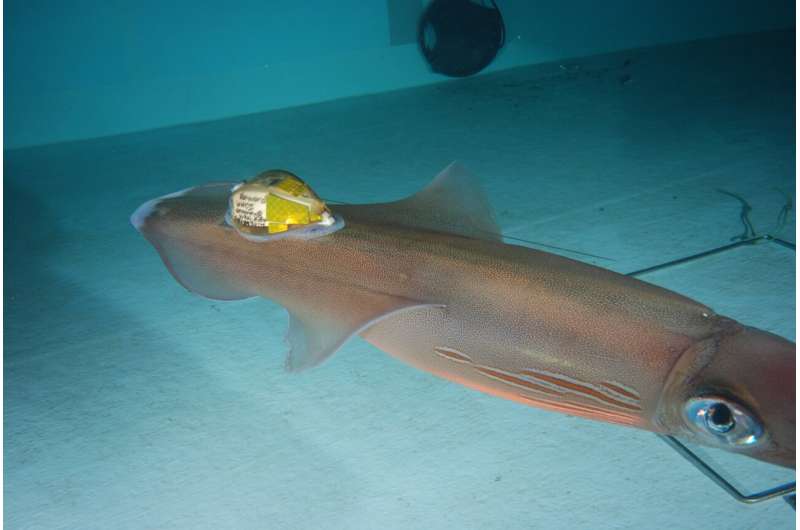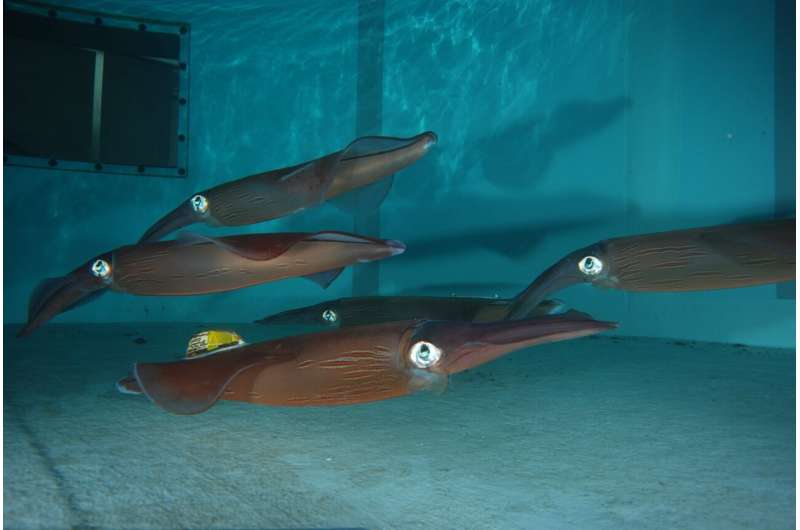This article has been reviewed according to Science X's editorial process and policies. Editors have highlighted the following attributes while ensuring the content's credibility:
fact-checked
peer-reviewed publication
trusted source
proofread
New tagging method provides bioadhesive interface for marine sensors on diverse, soft and fragile species

Tagging marine animals with sensors to track and study their movements can provide researchers with important environmental and behavioral information, including energy usage, habitat changes, and migration patterns. But existing techniques to attach sensors currently largely rely on invasive physical anchors, suction cups, and rigid glues. While these techniques can be effective for marine animals with hard exoskeletons and large animals such as sharks, the traditional tag attachment methods are not ideal for more fragile species, such as squid and jellyfish.
Now, a newly developed soft hydrogel-based Bioadhesive Interface for Marine Sensors, referred to as BIMS, holds promise as an effective, rapid, versatile, and non-invasive method to tag and track all sorts of marine species, including soft and fragile species that have long been difficult to access, according to a new journal article by scientists with the Woods Hole Oceanographic Institution (WHOI), Massachusetts Institute of Technology (MIT), and partner organizations.
The BIMS tagging can help researchers better understand animal behavior while also capturing oceanographic data critical for helping to better understand some impacts of climate change, and for resource management.
According to the article, "Bioadhesive Interface for Marine Sensors on Diverse Soft Fragile Species," published in Nature Communications, this technology will increase the monitoring of oceanographic conditions, species habitat use, and the overall behavior of animals that are important ecologically and are key protein source for people worldwide.
The way that this technique can scale up for various applications—such as applying sensors to previously unmonitored animals to track their condition and movements– "is the vision of this paper," said journal article co-lead-author Seth Cones, a Ph.D. candidate in the MIT/WHOI Joint Program in Oceanography/Applied Ocean Science & Engineering.
The BIMS effectiveness derives from it containing a thin layer of a dried-hydrogel adhesive specifically engineered to form strong physical and chemical bonds with animal tissues and rapidly absorb the seawater from the surface of a marine species. The sensors then can adhere, as a soft yet strong hydrogel that conforms to the organism's body shape, in less than 20 seconds. Other methods of tagging can take up to 8.5 minutes which can stress an animal, disturb natural behaviors, and affect data quality.
The researchers tested the BIMS applicability to species with distinct tissues, including squid, skate, flounder, and lobster. In these ethically approved tests—mostly conducted at a large saltwater pool at WHOI's Environmental Systems Laboratory, in addition to field testing in the Azores Islands, Portugal—BIMS was found to stay affixed to fragile aquatic animals for up to three days, which allows for long-term animal behavior monitoring.
The researchers tested a number of factors, including the interfacial toughness of the adhesive, adhesion stability, and its shear and tensile strength. They also assessed potential animal behavior disruption and found that the animals made a rapid return to baseline individual and group level behaviors.

"The BIMS allows us to sensor the animals and the oceans, so we can better predict the impact of climate change and other concerns affecting marine environments," said journal article co-author, Aran Mooney, an associate scientist in biology at WHOI.
Camilo Duque London, a graduate student in MIT's Department of Mechanical Engineering, added that another BIMS benefit is providing medicine to sick or injured animals, potentially including endangered species. The use of multiple sensors on one animal could also measure body kinematics and provide insights for designing bio-inspired marine robots. Future visions can integrate more sophisticated acoustic or optical sensors.
He also emphasized the importance of the research collaboration between engineering and the marine sciences. "This paper presents a new approach and a new tool, crafted through interdisciplinary collaboration, that could be used by marine biologists who study fragile species."
More information: T. Aran Mooney, Bioadhesive interface for marine sensors on diverse soft fragile species, Nature Communications (2024). DOI: 10.1038/s41467-024-46833-4. www.nature.com/articles/s41467-024-46833-4
Journal information: Nature Communications
Provided by Woods Hole Oceanographic Institution



















